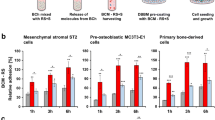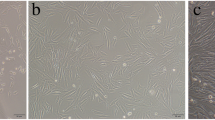Abstract
We have been studying the potential of human fibroblastic cells (HFC) from periapical granulation tissue to form a calcified matrix. Recently, we reported that inflamed periapical granulation tissue contains osteogenic cells. In the present study, we tested the hypothesis that HFC, cultured with decalcified bone (DB) of rat, might form much greater calcified matrices than with rat decalcified boiled bone (DBB), which was originally prepared as a negative control. HFC were cultured with DB or DBB in the presence or absence of 2 mM β-glycerophosphate (β-GP) and 50 μg/ml ascorbic acid. After six weeks of culture, a number of von Kossa-positive globular structures were unexpectedly observed inside DBB, but not DB. Without HFC, such structures were never seen in DBB incubated with 2 mM β-GP and 50 μg/ml ascorbic acid. DB cultured with HFC under the same conditions did not show these structures. Electron-microscopic observation revealed that matrix vesicles aggregated on collagen fibrils around globular structures in DBB. Energy dispersive X-ray microanalysis confirmed that these structures were calcified matrices composed of calcium and phosphate. These results suggest that human periapical granulation tissue contains cells responsible for the formation of calcified matrices in DBB, and that DBB could serve as an excellent scaffold for the calcification of HFC, rather than DB.




Similar content being viewed by others
References
Anderegg CR, Martin SJ, Gray JL, Mellonig JT, Gher ME (1991) Clinical evaluation of the use of decalcified freeze-dried bone allograft with guided tissue regeneration in the treatment of molar furcation invasions. J Periodontol 62:264–268
Becker W, Becker BE, Caffesse R (1994) A comparison of demineralized freeze-dried bone and autologous bone to induce bone formation in human extraction sockets. J Periodontol 65:1128–1133
Becker W, Urist MR, Tucker LM, Becker BE, Ochsenbein C (1995) Human demineralized freeze-dried bone: inadequate induced bone formation in athymic mice. A preliminary report. J Periodontol 66:822–828
Cochran DL, Douglas HB (1993) Augmentation of osseous tissue around nonsubmerged endosseous dental implants. Int J Periodontics Restorative Dent 13:506–519
Dupoirieux L, Costes V, Jammet P, Souyris F (1994) Experimental study on demineralized bone matrix (DBM) and coral as bone graft substitutes in maxillofacial surgery. Int J Oral Maxillofac Surg 23:395–398
Francis J, Brunsvold M, Prewett A, Mellonig J (1995) Clinical evaluation of an allogeneic bone matrix in the treatment of periodontal osseous defects. J Periodontol 66:1074–1079
Ito T, Sakano S, Sato K, Sugiura H, Iwata H, Murata Y, et al (1995) Sensitivity of osteoinductive activity of demineralized and defatted rat femur to temperature and duration of heating. Clin Orthop 316:267–275
Lin LM, Gaengler P, Langeland K (1996) Periradicular curettage. Int Endod J 29:220–227
Maeda H, Hashiguchi I, Nakamuta H, Toriya Y, Wada N, Akamine A (1999) Histological study of periapical tissue healing in the rat molar after retrofilling with various materials. J Endod 25:38–42
Maeda H, Wada N, Nakamuta H, Akamine A (2004) Human periapical granulation tissue contains osteogenic cells. Cell Tissue Res 315:203–208
Piattelli A, Scarano A, Corigliano M, Piattelli M (1996) Comparison of bone regeneration with the use of mineralized and demineralized freeze-dried bone allografts: a histological and histochemical study in man. Biomaterials 17:1127–1131
Pinholt EM, Haanaes HR, Roervik M, Donath K, Bang G (1992) Alveolar ridge augmentation by osteoinductive materials in goats. Scand J Dent Res 100:361–365
Reddi AH (1992) Regulation of cartilage and bone differentiation by bone morphogenetic proteins. Curr Opin Cell Biol 4:850–855
Sato T, Iwata H, Takahashi M, Miura T (1993) Heat tolerance of activity toward ectopic bone formation by rabbit bone matrix protein. Ann Chir Gynaecol Suppl 207:37–40
Schallhorn RG, McClain PK (1988) Combined osseous composite grafting, root conditioning, and guided tissue regeneration. Int J Periodont Rest Dent 8:8–31
Shigeyama Y, D’Errico JA, Stone R, Somerman MJ (1995) Commercially prepared allograft material has biological activity in vitro. J Periodontol 66:478–487
Shimizu K, Masumi S, Yano H, Fukunaga T, Ikebe S, Shin S (1999) Revascularization and new bone formation in heat-treated bone grafts.Arch Orthop Trauma Surg 119:57-61
Trowbridge HO, Emling RC (1989) Inflammation, 3rd edn. Quintessence Publishing, Chicago
Urist MR, Strates B (1970) Bone formation in implants of partially and wholly demineralized bone matrix. Clin Orthop 71:271–278
Urist MR, Silverman BF, Buring K, Dubuc FL, Rogenberg JM (1967) The bone induction principle. Clin Orthop 53:243–282
Zhang M, Powers R, Wolfinbarger L (1997) Effects of demineralization on DBM. J Periodontol 68:1085–1092
Acknowledgements
We appreciate the invaluable cooperation of the participating patients. We also thank Dr. Watanabe of JEOL for helpful assistance with the X-ray microanalysis.
Author information
Authors and Affiliations
Corresponding author
Additional information
This work was supported by grant-in-aid (project 15689024) for scientific research from the Ministry of Education, Culture, Sports, Science and Technology, Japan.
Rights and permissions
About this article
Cite this article
Maeda, H., Wada, N., Fujii, S. et al. Fibroblastic cells from human periapical granulation tissue preferentially form calcified matrices in decalcified boiled rat bone. Cell Tissue Res 320, 135–140 (2005). https://doi.org/10.1007/s00441-004-1052-x
Received:
Accepted:
Published:
Issue Date:
DOI: https://doi.org/10.1007/s00441-004-1052-x




